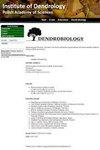欧洲最后一片天然林樟子松最古老树木的遗传资源
IF 1.8
4区 农林科学
Q2 FORESTRY
引用次数: 0
摘要
欧洲低地原始森林的最后一块碎片在比亚沃维耶森林(BF)中幸存下来。其林分的一个特点是具有复杂的多年龄结构。从遗传学的角度来看,老树代表了一个基因库,它是几个世纪以来选择力作用的产物。因此,对这些老树进行基因盘点并为子孙后代保存其遗传资源是极其重要的。本研究的目的是:1)对波兰Białowieża森林Sitki保护区最古老的樟子松进行基因分型;和2)这一古老的苏格兰松林的遗传结构特征。使用8个核微卫星标记对98棵树龄在100年以上的老树进行了分析。对BF中最古老的苏格兰松树的基因分型的第一项研究表明,每棵树都有一个独特的基因型,因此可以通过基因图谱明确地进行鉴定。总体而言,85%的树木表现出0.5或更高的个体杂合度。我们证明,核基因组的八个多态微卫星位点足以创建每棵树的个体遗传图谱。我们的研究结果将为樟子松本土遗传资源的保护提供必要的背景信息。本文章由计算机程序翻译,如有差异,请以英文原文为准。
Genetic resources of the oldest trees of Pinus sylvestris L. from the last natural forest in Europe
The last fragments of primeval forests in the European lowlands have survived in the Białowieża Forest (BF). A characteristic feature of its forest stands is a complex and multi-age structure. From a genetic perspective, old trees represent a genetic pool that is a product of the selection forces acting over centuries. Therefore, it is extremely important to make a genetic inventory of such old trees and preserve their genetic resources for future generations. The aims of this study were: 1) genotyping the oldest trees of Pinus sylvestris in the Sitki Reserve of the Białowieża Forest in Poland; and 2) characterisation of the genetic structure of this old Scots pine tree stand. In total, 98 old trees aged above 100 years were analysed using eight nuclear microsatellite markers. The first study on the genotyping of the oldest Scots pine trees in the BF, indicated that each of the trees has a unique genotype, so it can be unambiguously identified by a genetic profile. Overall, 85% of trees showed an individual heterozygosity of 0.5 or higher. We demonstrated, that eight polymorphic microsatellite loci of the nuclear genome are sufficient to create an individual genetic profile of each tree. Our results will provide necessary background information for the conservation of native genetic resources of Pinus sylvestris.
求助全文
通过发布文献求助,成功后即可免费获取论文全文。
去求助
来源期刊

Dendrobiology
农林科学-林学
CiteScore
2.20
自引率
11.10%
发文量
17
审稿时长
>12 weeks
期刊介绍:
Dendrobiology publishes original research articles and review articles related to the biology of trees and shrubs.
 求助内容:
求助内容: 应助结果提醒方式:
应助结果提醒方式:


